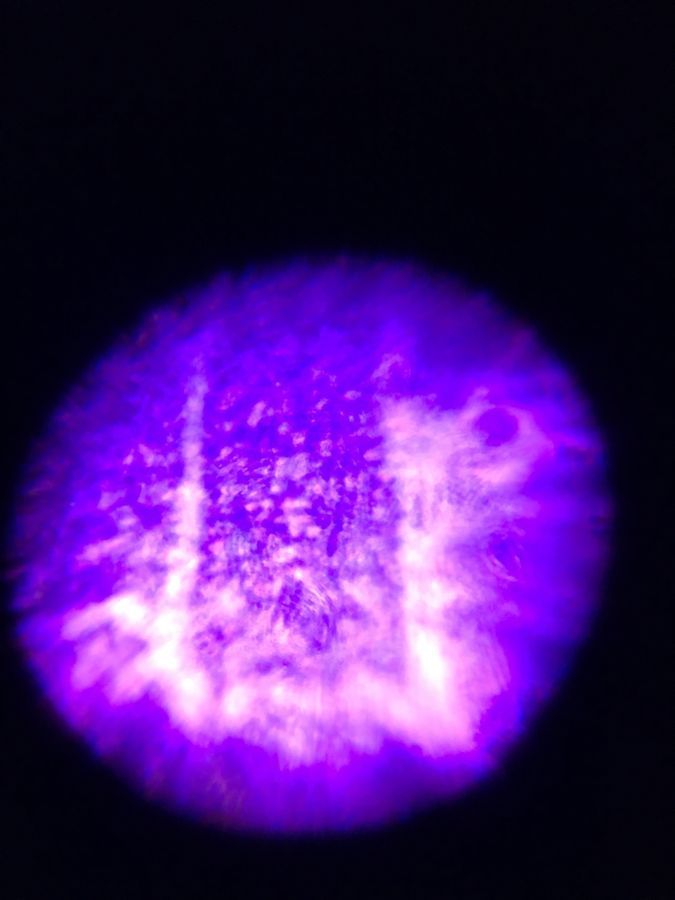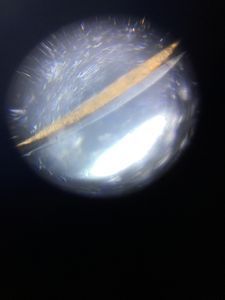A Splash of Color: Probing the Purple Petal
 Jan 22, 2019 • 4:59 PM UTC
Jan 22, 2019 • 4:59 PM UTC United States
United States 140x Magnification
140x Magnification Microorganisms
Microorganisms
chrpin
Learn about the author...
2posts
0comments
2locations

As someone who loves the color purple, the bright vibrancy of the purple flower instantly caught my attention. Coming from the frozen tundra that is the Northeast, any sort of color is a blessing miracle against the dull mediocrity of black, white, and gray that invade our wardrobes. Since moving to California for college, I was instantly appreciative of the small pockets of color I saw around campus even in the dead of January: pale pink peach (?) blossoms behind Wallenberg, bright orange citruses near FloMo and on the Row, and now this purple flower.

In order to collect the sample, I cut-off a small piece of a purple petal and placed a droplet of water between the slide and cover slip.
The first thing that struck me when I observed the petal under the Foldoscope was the fragmented, spotchy nature of its pigmentation. At the macro-level, the petal’s coloration was seamless and smooth, almost luxurious. At the micro-scale, I realized that the purple was actually found in small packets. This made me think of how pigments in plant cells are actually stored in their vacuoles (the “packets”), as opposed to simply diffuse throughout the cytoplasm. Although I am unsure the specific magnification the Foldoscope afforded me, I think it’s amazing that the Foldoscope, so much more lightweight and convenient to use than a standard light microscope, could afford the same insights that a biology textbook + microscope lab lesson could.
Overall, the petal was incredibly amazing to examine because it spurred within me questions about plant physiology, and directed my thoughts towards information I learned in my Raven’s Plant Biology textbook (nerdy, I know). In examining the texture of the flower petal, I began to hypothesize reasons why this surface would be texturized to begin with. Perhaps this pressure aids insect pollinators in their ability to grip onto the flower and access the nectar (or lack thereof in those flowers which falsely bait their pollinators), which thereby also enables the plant to deposit its pollen from the anthers onto the organism. I think an interesting project would be to compare the petal surfaces of different flowers which have different documented pollinators and examining if there is difference in the textures on their petals.
The first thing that struck me when I observed the petal under the Foldoscope was the fragmented, spotchy nature of its pigmentation. At the macro-level, the petal’s coloration was seamless and smooth, almost luxurious. At the micro-scale, I realized that the purple was actually found in small packets. This made me think of how pigments in plant cells are actually stored in their vacuoles (the “packets”), as opposed to simply diffuse throughout the cytoplasm. Although I am unsure the specific magnification the Foldoscope afforded me, I think it’s amazing that the Foldoscope, so much more lightweight and convenient to use than a standard light microscope, could afford the same insights that a biology textbook + microscope lab lesson could.
Overall, the petal was incredibly amazing to examine because it spurred within me questions about plant physiology, and directed my thoughts towards information I learned in my Raven’s Plant Biology textbook (nerdy, I know). In examining the texture of the flower petal, I began to hypothesize reasons why this surface would be texturized to begin with. Perhaps this pressure aids insect pollinators in their ability to grip onto the flower and access the nectar (or lack thereof in those flowers which falsely bait their pollinators), which thereby also enables the plant to deposit its pollen from the anthers onto the organism. I think an interesting project would be to compare the petal surfaces of different flowers which have different documented pollinators and examining if there is difference in the textures on their petals.
Sign in to commentNobody has commented yet... Share your thoughts with the author and start the discussion!

 0 Applause
0 Applause 0 Comments
0 Comments